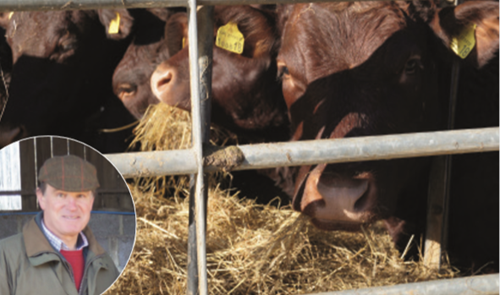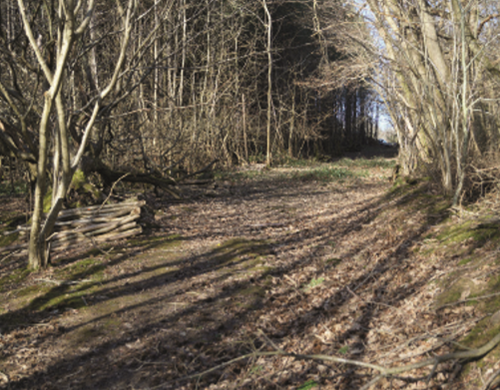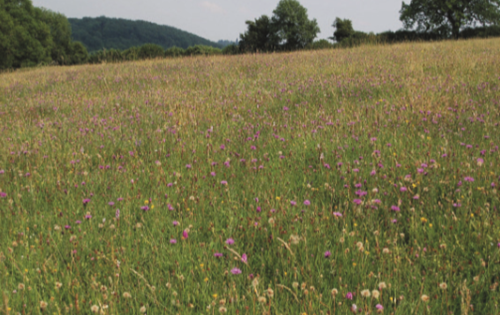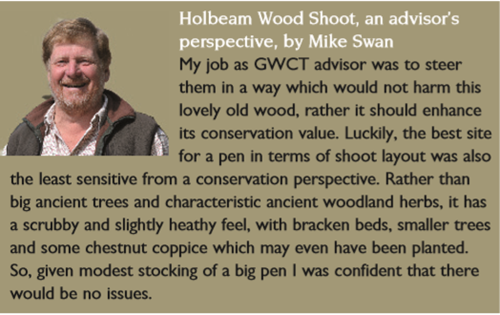In the first of a new series on Working Conservationists, Joe Dimbleby visits beef farmer James Mulleneux whose shoot is helping to restore woodland with advice from the GWCT.

James and Jane Mulleneux run the 340-acre Holbeam Wood Farm, in East Sussex, in the beautiful rolling hills of the High Weald AONB. The farm was once part of the neighbouring Whiligh Estate, which famously supplied the ancient oak for the Westminster Hall and came into the family in 1958 when it was bought by James’ grandfather. It divides into 250 acres of permanent pasture, 50 acres of arable and 40 acres of woodland and the shooting rights on a further 60 acres of Ancient Semi-Natural Woodland (ASNW). The pasture provides fodder for an award-winning herd of 50 native breed Sussex beef cattle.
James was brought up with an appreciation for nature and is determined to return some of the wildlife that existed on the farm when he was younger. He said: “I love the land and seeing birds and butterflies in summer, it all goes together. In the old days we employed Old Pom and all he did was fencing and cutting and laying the hedges by hand. Back then we had six people working on the farm, now I couldn’t afford to employ anybody full time. The way we manage the landscape has changed hugely. It is manicured with machinery and I have to make a conscious effort not to cut everything back.”
The farm entered a 10-year Higher Level Stewardship (HLS) agreement in 2009 with an emphasis on the restoration of species-rich grassland and native woodland. The UK has lost 97 percent of its traditional hay meadow, but at Holbeam wood the swards are maintained at a range of heights and different grass species and wildflowers have been sown including a mix of common bent, cock’s foot, timothy, crested dog’s tail, smooth meadow grass, meadow fescue, red fescue, black knapweed and ox-eye daisy.
James added: “Some of the leys we planted look fantastic. If we leave fields to cut hay it’s the most beautiful sight, full of insects and butterflies. Birds like linnets and skylarks have come back because grassland is allowed to go to seed.”

The shoot is central to the farm and brings essential conservation ingredients to the mix. It releases 2,800 pheasants in four pens, and shoots 11 days per year including one let day to cover costs and a beaters’ day. The average bag is 96. They top up the feeders and scatter feed throughout the winter and into the hungry gap, which benefits farmland birds and several game crops are located across the farm.
James is GWCT Sussex chairman and all members of the team belong to the GWCT. When the farm and syndicate bought the sporting rights on 60 acres of ancient woodland owned by a local charity called Bellhurst Nature Conservation Trust, he asked GWCT advisor Mike Swan how to minimise impact and increase biodiversity.

The Bellhurst trustees were aware that if too densely stocked, woodland in a release pen can be damaged by the birds. James said: “Mike suggested where the pen should be and we worked out the size according to the Code of Good Shooting Practice (700 birds per hectare).” In exchange for firewood, the shoot engages a woodsman to help coppice a new section every year. Letting the light back in has meant the understorey of smaller plants, flowers and brambles has returned providing habitat for woodland birds and butterflies. The other key part of woodland management is deer and predator control.
The shoot cannot afford to employ a full-time gamekeeper but a part-time gamekeeper Doug and a team of stalkers, Steve, Graham, Dave and Mike, share the work between them. Last season the team accounted for 54 squirrels and 14 deer, both of which can damage the trees and understorey if not managed properly. James believes farming and game management holds the key to countryside restoration: “In the end, we have this special landscape in Britain and we must look after it.
The most cost-effective solution is for farmers to do it, and we have a duty to show how we can be on the side of the angels.”

Working conservationists
This article is an extract from a new GWCT publication of case studies of conservationminded farmers, landowners and gamekeepers from across the UK. These personal stories look at how private individuals have successfully combined farming or shooting with wildlife restoration, what inspires them and what advice and support they have received. To order a copy, visit www.gwct.org.uk/working. To feature in a future case study, please contact Joe at jdimbleby@gwct.org.uk.